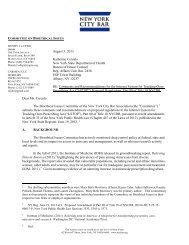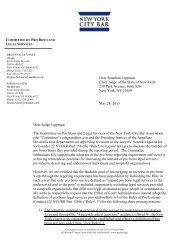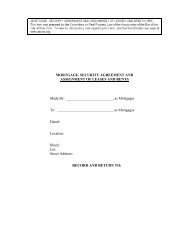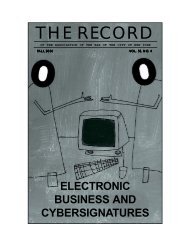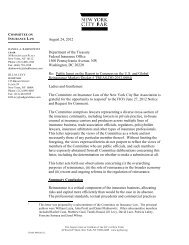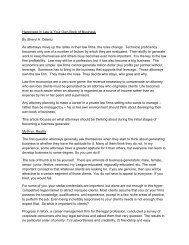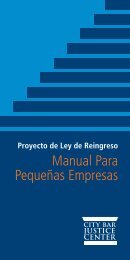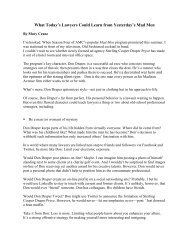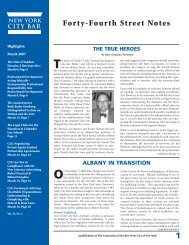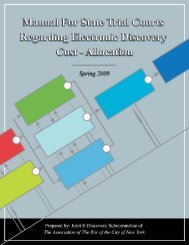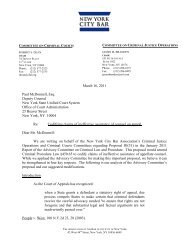2007 Issue 1 - New York City Bar Association
2007 Issue 1 - New York City Bar Association
2007 Issue 1 - New York City Bar Association
Create successful ePaper yourself
Turn your PDF publications into a flip-book with our unique Google optimized e-Paper software.
W E B S I T E A C C E S S I B I L I T Y F O R P E O P L E W I T H D I S A B I L I T I E S<br />
and failure to modify existing “practices,” thereby relegating people with<br />
disabilities to “lesser services, programs, activities, benefits [and] other<br />
opportunities” and “inferior status in our society” as an “insular minority”<br />
that is denied “full participation” in American life. 42<br />
Public accommodations Websites, although “not anticipated by Congress,”<br />
clearly must be subject to Title III. Without Website access to public<br />
accommodations, people with disabilities are “isolated and segregated”<br />
and relegated to “lesser services.” They are unable to order CDs from online<br />
bookstores, to download tunes from online music stores, to take virtual<br />
tours and make online reservations at hotels, to read and consider online<br />
restaurant menus, to order from online pharmacies and groceries. As more<br />
and more advertisements urge customers to visit a store or museum’s Website<br />
for goods, services and information, and even grant special deals to online<br />
consumers (and the convenience of avoiding long telephone queues), those<br />
who cannot access the Website are denied the “full participation” that<br />
Congress intends. Website inaccessibility is thus a “communication barrier”<br />
that is “faced day-to-day by people with disabilities.”<br />
Congressional intent also is evident from the legislative history of<br />
the ADA. 43 The legislative history (the Senate and House Reports on the<br />
ADA) 44 is explicit that Congress intended that the language of the ADA<br />
not be frozen in time, but that it adapt to changing needs and circumstances,<br />
specifically technological change. As the House Report says, “the<br />
Committee intends that the types of accommodation and services provided<br />
to individuals with disabilities, under all of the titles of this bill,<br />
should keep pace with the rapidly changing technology of the times.” 45<br />
Central to Title III is equal access, not to physical places, but to goods<br />
and services, with physical accessibility only a means to that end. “In<br />
drafting Title III, Congress intended that people with disabilities have<br />
equal access to the array of goods and services offered by private estab-<br />
42. Id. § 12101 (a)(5), (6), (7), (8).<br />
43. See Carparts Distrib. Cntr., Inc. v. Automotive Wholesalers Ass’n of <strong>New</strong> England, 37<br />
F.3d 12, 19 (1 st Cir. 1994) (“Even if the meaning of ‘public accommodation’ is not plain, it is,<br />
at worst, ambiguous. This ambiguity, considered together with agency regulations and public<br />
policy concerns, persuades us that the phrase is not limited to actual physical structures.”); but<br />
see Parker v. Metropolitan Life Ins. Co., 121 F.3d 1006, 1014 & n.10 (6 th Cir. 1997) (No need<br />
to visit legislative history, because Title III’s statutory language clearly and unambiguously<br />
means that “a public accommodation is a physical place”).<br />
44. S. Rep. No. 101-116 (1989), H.R. Rep. No. 101-485 (1990), reprinted in 1990 U.S.C.C.A.N.<br />
267.<br />
45. H.R. Rep. No. 101-485, pt. 2, at 108, reprinted in 1990 U.S.C.C.A.N. 303, 391.<br />
2 0 0 7 V O L. 6 2 , N O. 1<br />
129



